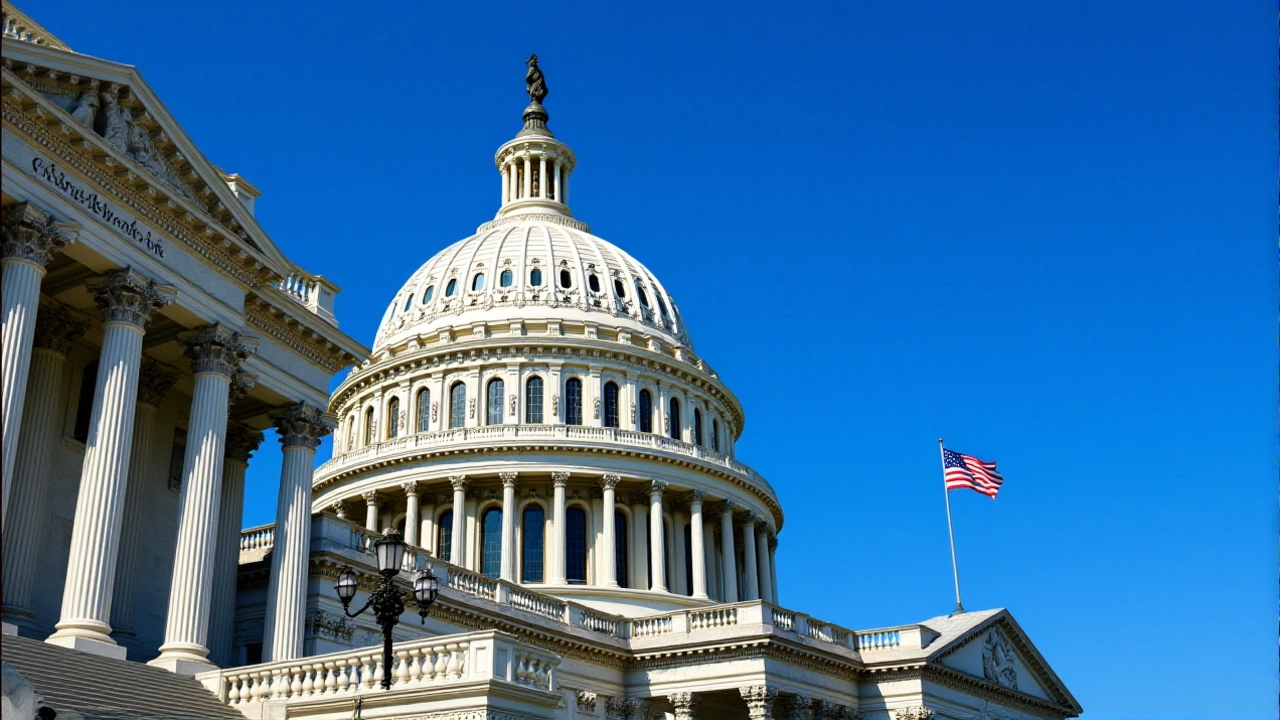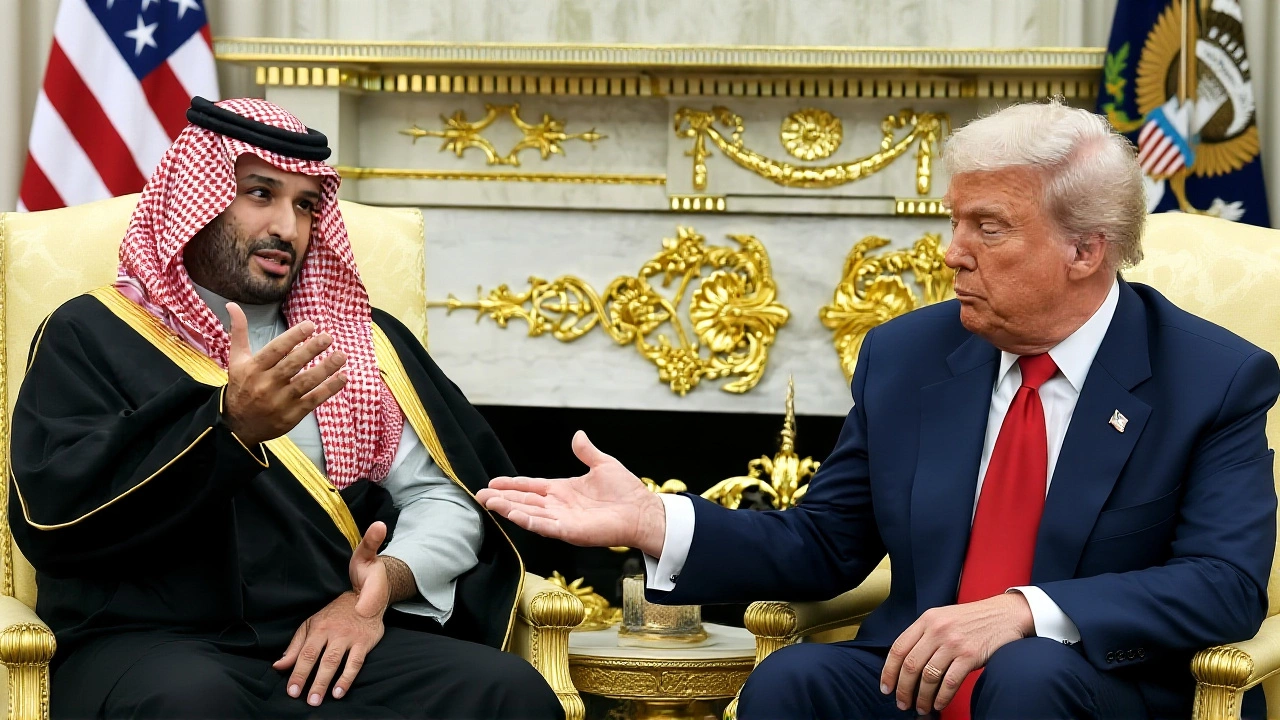Saudi Crown Prince Pledges $1 Trillion to U.S. in Historic Investment Deal
 Nov, 21 2025
Nov, 21 2025
On November 18, 2025, Mohammed bin Salman Al Saud, Crown Prince and Prime Minister of the Kingdom of Saudi Arabia, stunned Washington with a nearly $1 trillion investment pledge to the United States — the largest foreign capital commitment in U.S. history. The announcement, made during a private meeting with Donald John Trump, the 45th President of the United States, in the White House at 1600 Pennsylvania Avenue NW, didn’t just signal economic goodwill. It rewrote the rules of U.S.-Saudi relations, tying energy, defense, and technology into one tightly woven package — and doing it with a handshake, not a treaty.
A Deal Decades in the Making
This wasn’t a surprise out of nowhere. Saudi Arabia’s Public Investment Fund (PIF) has been quietly building U.S. exposure for years — buying stakes in U.S. oil giants like ExxonMobil, snapping up Manhattan office towers, and investing in Silicon Valley startups. But those were drops in the ocean compared to what’s now on the table. The $600 billion pledge from Trump’s May 2025 visit to Riyadh was already historic. Now, that number has nearly doubled. And the money isn’t sitting in Treasury bonds. It’s meant to flow directly into American factories, data centers, ports, and highways — all 50 states, according to the White House fact sheet released on November 20, 2025.What’s Actually in the Pledge?
The details are still emerging, but here’s what’s confirmed: $1 trillion over the next year, starting November 19, 2025. The bulk targets infrastructure, advanced manufacturing, and artificial intelligence. Think electric vehicle charging networks in rural Ohio, semiconductor fabs in Arizona, and AI-powered logistics hubs in Texas. The White House says the goal is to "create high-wage American jobs" — a phrase Trump repeated at the post-meeting dinner. "You’ve agreed to invest $600 billion into the United States," he told reporters, "and because he’s my friend, he might make it a trillion. But we can count on 600." But there’s more. Saudi Arabia agreed to purchase nearly 300 M1A2 Abrams tanks from General Dynamics — a deal that directly supports over 12,000 U.S. manufacturing jobs in Pennsylvania, Indiana, and Ohio. And while not yet official, Saudi officials signaled serious interest in acquiring Lockheed Martin F-35 Lightning II fighter jets. That would require a complex licensing agreement with the U.S. Department of Defense, and it’s a major shift — Washington has long restricted F-35 sales to allies with advanced air defense integration, and Saudi Arabia has never been on that list.The Diplomatic Chessboard
The money isn’t the only story. In the same meeting, Crown Prince Mohammed bin Salman signaled a dramatic pivot in Middle East diplomacy. He reopened direct channels with the Islamic Republic of Iran — a move that caught U.S. intelligence off guard. At the same time, he revived quiet talks about normalizing relations with the State of Israel, building on the 2020 Abraham Accords. The U.S. sees this as a strategic win: a Saudi-led regional détente that could reduce pressure on American troops in the Gulf. "There are no limits," the Crown Prince reportedly said. And for once, he wasn’t exaggerating.
Why This Matters to Every American
This isn’t just about Wall Street or Pentagon contracts. It’s about your town. The $1 trillion isn’t going to a single fund in New York. The White House says it will be distributed across all 50 states — meaning small businesses in Iowa could get grants to upgrade to AI-driven supply chains. Community colleges in Georgia could partner with Saudi tech firms to train workers in robotics. Even your local electric utility might get funding to expand grid resilience. And unlike past Saudi investments — which often came with strings attached on energy policy — this one is tied to American job creation, with no conditions on U.S. domestic decisions. Historically, Saudi capital flowed into the U.S. quietly — mostly through sovereign wealth funds and long-term bond holdings. Under Obama and Bush, it was steady but cautious. Under Trump’s first term, it spiked — but never to this scale. This is the first time a foreign nation has pledged an amount greater than the entire annual U.S. federal infrastructure budget. And it’s happening while the U.S. is trying to outpace China in AI, semiconductors, and clean energy. The timing isn’t accidental.What Comes Next?
The White House promised detailed releases in the coming weeks — on defense coordination, chip licensing deals with firms like Intel and NVIDIA, and the framework for Middle East diplomacy. The U.S. Department of Commerce and Saudi Ministry of Investment are already forming joint working groups. Meanwhile, Congress is bracing. Some lawmakers are wary of Saudi influence, especially after the 2018 Jamal Khashoggi killing. Others see opportunity. "This is the biggest economic lifeline we’ve had since the 2009 stimulus," said Senator John Cornyn (R-TX) in a private briefing. "But we need transparency. Not just money — accountability." The Crown Prince’s team has already begun sending technical teams to Silicon Valley, Detroit, and Houston. The message is clear: Saudi Arabia isn’t just writing checks. It’s building partnerships.
Is This Sustainable?
The numbers are staggering. $1 trillion in one year? That’s more than the entire GDP of Saudi Arabia in 2024. But here’s the catch: the pledge isn’t cash on hand. It’s a commitment to deploy capital over time — likely through PIF, Saudi sovereign wealth vehicles, and private consortiums. The money will come from divesting from non-core assets, including stakes in European energy firms and Asian real estate. It’s part of Vision 2030, the Crown Prince’s 10-year plan to wean the kingdom off oil. And the U.S. is now its most important bet.Frequently Asked Questions
How will this $1 trillion investment affect U.S. jobs?
The White House estimates the investment will create between 1.2 million and 1.8 million direct and indirect jobs across manufacturing, construction, tech, and logistics. The tank deal alone supports 12,000 jobs in five states. Additional funding for AI infrastructure and semiconductor production is expected to add 500,000 high-skill positions, particularly in states like Arizona, Texas, and Michigan. Local governments are already preparing workforce training programs to meet demand.
What’s the difference between this pledge and previous Saudi investments in the U.S.?
Past investments — totaling around $80 billion since 2000 — were mostly in Treasury bonds, real estate, and energy assets. This $1 trillion pledge is targeted: infrastructure, tech, and defense manufacturing. It’s not passive ownership; it’s active partnership. The funds are tied to job creation, with no financial returns required. That’s unprecedented. Even the $600 billion pledge from May 2025 didn’t include the same level of sectoral specificity or geographic distribution across all 50 states.
Why is Saudi Arabia making this move now?
Saudi Arabia’s Vision 2030 plan needs foreign capital to diversify its economy away from oil. With global energy markets shifting, the kingdom is betting big on the U.S. as its most stable, high-growth partner. At the same time, regional tensions with Iran and the stalled Israel-Palestine peace process make Saudi diplomacy urgent. Aligning with Washington gives Riyadh geopolitical leverage — and access to cutting-edge tech it can’t get elsewhere.
Could the U.S. Congress block any part of this deal?
Yes — particularly the F-35 jet sale, which requires congressional approval under the Arms Export Control Act. Lawmakers from both parties have raised concerns about Saudi Arabia’s human rights record and its military actions in Yemen. While the administration argues the deal strengthens regional stability, some senators are preparing amendments to require transparency reports and human rights benchmarks before any defense transfer. The tank deal, however, is less controversial and expected to move forward quickly.
What role does the Public Investment Fund play in this deal?
The Public Investment Fund (PIF) is the primary vehicle for deploying the $1 trillion. With over $900 billion in assets under management, PIF has already invested $40 billion in U.S. assets since 2019. This new commitment will likely be channeled through new joint ventures with U.S. firms like BlackRock, General Electric, and Microsoft. PIF’s leadership has promised to avoid speculative real estate and focus on productive infrastructure — a deliberate shift from its earlier portfolio.
How does this impact U.S.-China economic competition?
This deal is a direct counter to China’s Belt and Road Initiative. While Beijing has spent $1 trillion globally on infrastructure, much of it comes with debt traps and political strings. Saudi Arabia’s U.S. pledge, by contrast, is transparent, job-focused, and tied to American standards. It signals to other nations that the U.S. remains the preferred partner for high-value investment — not just because of its market size, but because of its rule of law and innovation ecosystem. China’s state media called the deal "a political stunt," but analysts say it’s reshaping global capital flows.